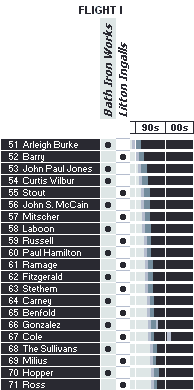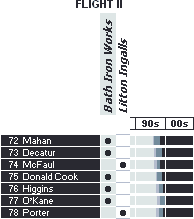USS Arleigh Burke (DDG 51) in the Kennebec River.
GENERAL INFORMATION
Length: 505 feet (overall); 466 feet (waterline).
Beam: 66 feet max; 59 feet waterline.
Displacement: 6,600 long tons light; 8,300 tons full load.
Construction: steel hull and superstucture; aluminium funnels.
Propulsion machinery: 4 gas turbines: 100,000 shp; 2 shafts with 5-bladed controllable reversible pitch (CRP) propellers.
Designed speed: 31+ knots.
Endurance: 4,890 nm @ 20 knots.
Designed complement: 32 officers; 348 enlisted.
The Arleigh Burke class was designed from the outset with future modifications in mind.
- Flight I consisted of USS Arleigh Burke, built at Bath. There was a pause after her construction for evaluation.
- Flight IA commenced with Barry, launched from Pascagoula, and included the 20 ships commissioned through 1997.
- Flight II consisted of seven ships authorized in fiscal year 1992. Commissioned in 1998 and 1999, they incorporated improvements to the SPY radar, Standard missile, active electronic countermeasures and communications systems.
DAMAGE
Two Flight IA ships incurred unusual damage early in their careers:
- Commissioned 12 October 1996, Gonzalez gounded while leaving the Caribbean anchorage at St. Maartin the following month during her shakedown cruise. Making Roosevelt Roads, Puerto Rico and towed from there back to Bath, she at first faced decommissioning but her hull, sonar and propulsion systems were “reconstructed” at a cost of $10 million and she returned to service in September 1997.
- On 12 October 2000, Cole was damaged by a terrorist attack in port at Aden, Yemen. An explosion opened a 40x40-foot hole in her port side, killing 17 and wounding 39. Returned to Pascagoula by the Norwegian heavy lift ship MV Blue Marlin, she was repaired and returned to service on 19 April 2002.
MODIFICATIONS1
In 2010, John Paul Jones and Arleigh Burke were taken into shipyards at San Diego and Norfolk respectively, the first two ships to commence a comprehensive mid-life upgrade to enhance warfighting capability and decrease total cost of operation. Modifications are being made in two phases:
Phase I — Hull, mechanical, and electrical systems (HM&E) improvements, including digitization of bridge and engineering systems. Rewiring includes replacing conventional cable with fiber optics. Habitability improvements include an advanced galley. Complement is being reduced by about 100 to 240 officers and enlisted personnel.
Phase II — Warfighting improvements for sea-based ballistic missile defense and improved radar performance in littoral operations.


